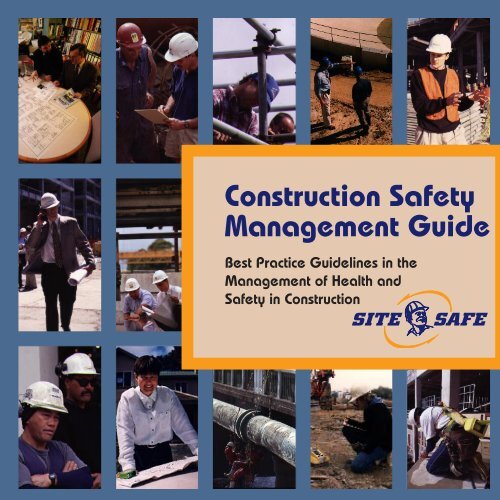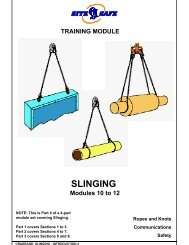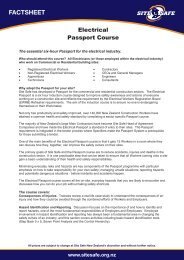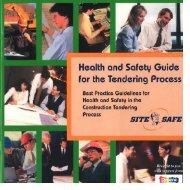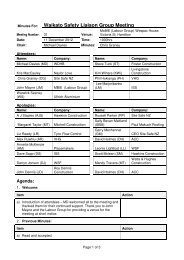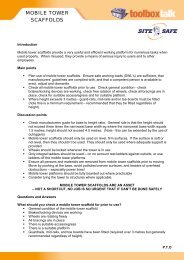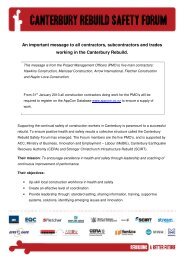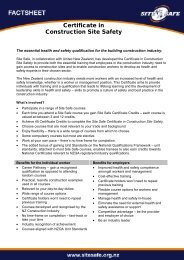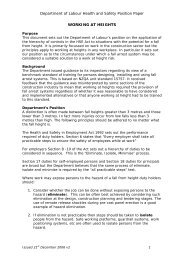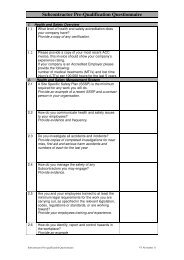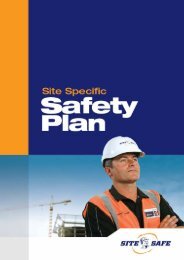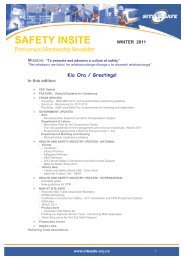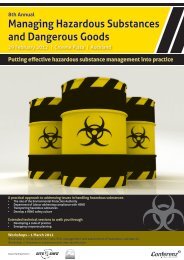Construction Safety Management Guide - Site Safe
Construction Safety Management Guide - Site Safe
Construction Safety Management Guide - Site Safe
Create successful ePaper yourself
Turn your PDF publications into a flip-book with our unique Google optimized e-Paper software.
<strong>Construction</strong> <strong><strong>Safe</strong>ty</strong><br />
<strong>Management</strong> <strong>Guide</strong><br />
Best Practice <strong>Guide</strong>lines in the<br />
<strong>Management</strong> of Health and<br />
<strong><strong>Safe</strong>ty</strong> in <strong>Construction</strong>
Published by <strong>Site</strong> <strong>Safe</strong> New Zealand<br />
22 The Terrace<br />
Wellington<br />
New Zealand<br />
First Edition: May 1999<br />
ISBN 0-473-06016-7
Contents<br />
A Word About <strong>Site</strong> <strong>Safe</strong> 4<br />
Acknowledgements 5<br />
About This <strong>Guide</strong> 6<br />
The Health And <strong><strong>Safe</strong>ty</strong> In Employment Act 7<br />
Health And <strong><strong>Safe</strong>ty</strong> Action Planning – Key Points 10<br />
The <strong>Construction</strong> Project – In Brief 11<br />
Key Tasks And Who Does Them 14<br />
Health And <strong><strong>Safe</strong>ty</strong> Planning 18<br />
Key Terms And What They Mean 21
A Word About <strong>Site</strong> <strong>Safe</strong><br />
A Word About <strong>Site</strong> <strong>Safe</strong><br />
<strong>Site</strong> <strong>Safe</strong> is a small independent organisation set up by the construction industry. Its<br />
single job is to reduce construction injuries and deaths by taking the lead in<br />
promoting construction site safety. This guide is the first step towards that goal.<br />
<strong>Construction</strong> <strong><strong>Safe</strong>ty</strong> <strong>Management</strong> <strong>Guide</strong> 4
Acknowledgements<br />
<strong>Site</strong> <strong>Safe</strong> would like to thank the Accident Rehabilitation and Compensation<br />
Insurance Corporation (ACC) and the Building and <strong>Construction</strong> Industry Training<br />
Organisation (BCITO) for financial assistance to develop this guide, as well as the<br />
following organisations:<br />
• Fletcher <strong>Construction</strong><br />
• Hartner <strong>Construction</strong><br />
• Hawkins <strong>Construction</strong> Ltd.<br />
• Mainzeal<br />
Many other organisations and individuals from various industry sectors have<br />
been involved in both the consultation and development process. OSH in particular<br />
made a contribution to the writing and formatting of the guide. <strong>Site</strong> <strong>Safe</strong> and the<br />
construction industry would like to thank all those involved.<br />
Acknowledgements<br />
<strong>Construction</strong> <strong><strong>Safe</strong>ty</strong> <strong>Management</strong> <strong>Guide</strong> 5
About This <strong>Guide</strong><br />
About This <strong>Guide</strong><br />
<strong>Construction</strong> can be a hazardous business. This is widely recognised by OSH, and<br />
everyone in the construction industry. When accidents happen, the costs are high – in<br />
people, profits and productivity.<br />
One of the best ways to avoid injuries and minimise costs is through good<br />
planning and co-ordination – both before and on the job.This should start when the<br />
decision is made to go ahead with the project, and should consider all stages and parties<br />
associated with the work. In this case, the size of the job doesn’t matter — systems do.<br />
This guide is intended as a useful tool to provide all players in the construction<br />
industry with a better understanding of their roles and responsibilities under the Health<br />
and <strong><strong>Safe</strong>ty</strong> in Employment Act (HSE Act 1992).<br />
More than that, it tries to present a picture of what is possible – a future where<br />
site safety in New Zealand is as good as, or even better than, the best in the world.<br />
It’s also worth noting that following this guide could help you provide a means<br />
of demonstrating the practicable steps you have taken to fulfil your responsibilities.<br />
This guide is not intended as a step by step guide to the HSE Act, nor is it a<br />
guide to planning and on-site processes. It is intended to reinforce the<br />
understanding of the various roles people involved with construction may<br />
have and how they can assess their performance in these roles.<br />
Future sector-specific workplace guides will contain more detail to support<br />
this guide. But, if you need to know more now, the Act is readily available<br />
from Bennett’s Government Bookshops and selected stationers.<br />
What’s in the <strong>Guide</strong>?<br />
The guide has been developed in consultation with representatives of the construction<br />
industry, OSH, building/property owners and developers, and architects and engineers.<br />
It includes:<br />
• a brief overview of the purpose and requirements of the Act<br />
• an explanation of the roles, responsibilities and key tasks of everyone working<br />
on a project<br />
• a list of important terms and what they mean<br />
Note: Throughout this guide, terms marked with an asterisk* are defined in<br />
the section Key Terms and What They Mean (pp.21-23).<br />
<strong>Construction</strong> <strong><strong>Safe</strong>ty</strong> <strong>Management</strong> <strong>Guide</strong> 6
The Health And <strong><strong>Safe</strong>ty</strong> In Employment Act – A Brief<br />
Introduction<br />
The main purpose of the Health and <strong><strong>Safe</strong>ty</strong> in Employment Act is to make the<br />
workplace safer through better management of health and safety.<br />
Everyone involved in a construction project is responsible under the Act,<br />
including:<br />
Work Group:<br />
Clients<br />
Designers/ advisers*<br />
(includes architects, engineers,<br />
consultants etc.)<br />
Head contractors*<br />
Subcontractors<br />
Employees<br />
Roles you could have:<br />
Principal*, employer, person who controls a place<br />
of work*.<br />
Principal, employer, self-employed,<br />
employee.<br />
Principal, employer, subcontractor,<br />
person who controls a place of work.<br />
Principal, subcontractor, employer, self-employed,<br />
person who controls a place of work.<br />
Employee, subcontractor.<br />
Though the client has responsibility as a ‘principal,’ several people can be<br />
principals at any one time, and all key people involved in a project have a duty to<br />
provide for the health and safety needs of their own areas of operation.<br />
Note: Anyone who contracts another party for any part of a construction<br />
project (that is, has engaged anyone to work on the project for gain or reward<br />
other than an employee) has a duty as a ‘principal’. Remember, you may be<br />
wearing more than one ‘hat’ at any particular stage of the project.<br />
However, this does not apply when work is being done on or in your own home<br />
– though information found in this guide may still be useful in this situation.<br />
The Health And <strong><strong>Safe</strong>ty</strong> In Employment Act – A Brief Introduction<br />
<strong>Construction</strong> <strong><strong>Safe</strong>ty</strong> <strong>Management</strong> <strong>Guide</strong> 7
The Health And <strong><strong>Safe</strong>ty</strong> In Employment Act – A Brief Introduction<br />
What the Act Requires for Principals<br />
Principals are required to take ‘all practicable steps’* to ensure the health and safety of<br />
people contracted by them to carry out work of any kind throughout all stages of a<br />
project. In terms of ‘best practice’, they also have a duty to consider the safety of<br />
others who may be affected by the project, such as the public.<br />
To achieve this, the principal (depending on their knowledge and experience)<br />
may need help from designers/advisers, contractors and subcontractors.<br />
The steps required will depend on the size and scope of each project. The<br />
larger the project, the wider the range will be of possible risks and hazards.<br />
Designers/advisers in particular need to consider the potential effect of their<br />
actions and designs* on the health and safety of those carrying out the work and<br />
others affected by it.<br />
What it Means on the Job<br />
In short, everyone involved with a construction project of any kind — from planners,<br />
designers and supervisors through to on-site workers — have a role to play in the<br />
management of health and safety during a construction project. This level of duty* for<br />
each duty holder* doesn’t go beyond what is reasonable for them to take.<br />
Remember to keep records:<br />
Maintaining a record (a ‘paper trail’) of all the steps you have taken for the<br />
health and safety of any project under your control is the best means you have<br />
of demonstrating how you have complied with the obligations you hold.<br />
<strong>Construction</strong> <strong><strong>Safe</strong>ty</strong> <strong>Management</strong> <strong>Guide</strong> 8
The Principal to Contractor Relationship<br />
Principal relationship<br />
Possible principal<br />
relationship<br />
Duty link you may have<br />
Though you may not have<br />
directly engaged the groups<br />
several steps removed from<br />
you, you still have a duty to<br />
ensure their safety to a level<br />
that could be reasonably<br />
expected of you.<br />
What you can do will usually<br />
decrease the further you are<br />
removed from their<br />
engagement, but you are still<br />
required to do what could be<br />
reasonably expected given the<br />
circumstances.<br />
For example: the head<br />
contractor is usually more able<br />
to influence general site safety,<br />
and less able to influence how<br />
subcontractors carry out<br />
specialist tasks for which the<br />
head contractor has no<br />
expertise.<br />
CLIENT<br />
Principal<br />
DESIGNER/<br />
ADVISER<br />
HEAD CONTRACTOR<br />
Principal<br />
(Responsible for<br />
construction process)<br />
SUB-<br />
CONTRACTOR 1<br />
SUB-<br />
CONTRACTOR 2<br />
Principal<br />
SUBCONTRACTOR a<br />
The client may choose to engage<br />
a designer/adviser to act on their<br />
behalf, or they may choose to<br />
directly engage a contractor(s).<br />
In either case, the client has the<br />
role and responsibilities of a<br />
principal to the groups below.<br />
In some instances, the designer/<br />
adviser will simply act as the<br />
client’s agent.<br />
Where a designer/adviser directly<br />
contracts with the head<br />
contractor, the designer/adviser<br />
may take on the role and<br />
responsibilities of a principal to<br />
the contractor(s) and the groups<br />
below.<br />
Designers/advisers may also be<br />
engaged by the contractor(s)<br />
(essentially as a subcontractor) to<br />
design the works, the construction<br />
processes and temporary works.<br />
If the head contractor then<br />
engages subcontractors to assist<br />
in the construction, the head<br />
contractor then takes on the role<br />
and responsibilities of a principal<br />
to the sub-contractors and the<br />
groups below.<br />
If the subcontractor (2)<br />
then<br />
chooses to engage a further<br />
subcontractor (a)<br />
to assist with their<br />
work, they too take on the role<br />
and responsibilities of a principal<br />
to the subcontractor (a).<br />
The Health And <strong><strong>Safe</strong>ty</strong> In Employment Act – A Brief Introduction<br />
<strong>Construction</strong> <strong><strong>Safe</strong>ty</strong> <strong>Management</strong> <strong>Guide</strong> 9
Health And <strong><strong>Safe</strong>ty</strong> Action Planning – Key Points<br />
Health And <strong><strong>Safe</strong>ty</strong> Action Planning – Key Points<br />
The seven important points for successful planning include:<br />
• A commitment to safe practice<br />
• Knowledge/expertise<br />
• Effective management<br />
• Co-ordination/communication/feedback<br />
• Information<br />
• Training<br />
• Monitoring/reporting<br />
The <strong>Construction</strong> Project — in Brief<br />
<strong>Construction</strong> <strong><strong>Safe</strong>ty</strong> <strong>Management</strong> <strong>Guide</strong> 10
The <strong>Construction</strong> Project — In Brief<br />
Where Health and <strong><strong>Safe</strong>ty</strong> Planning Fits and Who is<br />
Responsible<br />
Area of work to be considered<br />
Planning and design<br />
Preparation of health and safety plans<br />
Selection of designers and contractors<br />
Planning and scheduling of the work<br />
Responsibility (‘the team’)<br />
Client, designers/advisers<br />
Client, designers/advisers, contractors<br />
Client, designers/advisers<br />
Designers/advisers, contractors<br />
The <strong>Construction</strong> Project — In Brief<br />
Carrying out the construction work* or<br />
parts of it<br />
Advisers, contractors<br />
Before You Start<br />
The Team: Client, Designers/Advisers, Contractors<br />
The client decides to go ahead with construction work (this may include repairing,<br />
refurbishing, demolishing or maintaining a structure). Decisions are made regarding<br />
the overall plan, initial design, and construction methods that will affect health and<br />
safety throughout the project.<br />
<strong>Construction</strong> <strong><strong>Safe</strong>ty</strong> <strong>Management</strong> <strong>Guide</strong> 11
The <strong>Construction</strong> Project — In Brief<br />
A Special Word to Clients<br />
To date, you’ve probably already spent a considerable amount of time and<br />
money complying with Government and Local Authority legislation and<br />
planning requirements.<br />
At this point you take on the role of a ‘principal’* under the HSE<br />
Act.<br />
As a principal, you now have the duty to make sure that people or<br />
organisations you may contract to carry out the various stages of your<br />
project are safe while working on the site. You’re the person who has the<br />
authority and responsibility to make sure that health and safety is<br />
managed and co-ordinated and that the necessary steps are taken to make<br />
this happen by all those involved in the project.<br />
So it’s in your interests to make sure that health and safety are<br />
integral to the total planning for the project.<br />
Points to Consider<br />
To be sure you are meeting requirements at this early stage, make sure<br />
you consider the following points:<br />
• Designers and advisers you have appointed have the necessary<br />
health and safety knowledge and experience.<br />
• Timeframes and budgets will allow health and safety provisions<br />
to be included in the project.<br />
• Procedures will be in place to assess contractors’ ability to<br />
manage and control health and safety on the project.<br />
• Plans to monitor on-site health and safety will be included.<br />
• All relevant health and safety information about the project,<br />
such as any known hazards, will be provided to the advisers and<br />
contractors.<br />
• Procedures will be developed to make sure there is ongoing<br />
co-ordination of information and activity between all contractors<br />
(and the client) during construction.<br />
<strong>Construction</strong> <strong><strong>Safe</strong>ty</strong> <strong>Management</strong> <strong>Guide</strong> 12
Stage 1&2 –The Project Begins/ Design and Planning<br />
The Team: Client, Designers/Advisers<br />
Detailed design and planning work is done, giving consideration to health and safety<br />
at each stage. Final production information (such as drawings and specifications) are<br />
produced. Preparation of information for the tendering process begins, including the<br />
pre-tender health and safety requirements.<br />
Stage 3 – Tender/Selection<br />
The Team: Client, Designers/Advisers, Head Contractors<br />
Tender documentation is finalised. Pre-qualification procedures and the pre-tender<br />
health and safety site requirements are checked and used to make sure that the<br />
contractors have made adequate provisions for health and safety and are competent to<br />
carry them out.<br />
The <strong>Construction</strong> Project — In Brief<br />
Stage 4 – <strong>Construction</strong><br />
The Team: Client, Designers/Advisers, Head Contractor,<br />
Subcontractors<br />
The selected head contractor plans, programmes and prepares the construction work<br />
methods. A site-specific health and safety plan is developed, implemented, monitored<br />
and updated throughout the construction stage. Health and safety plans of contractors<br />
and subcontractors are monitored until the project is completed and all trades have<br />
left the site.<br />
<strong>Construction</strong> <strong><strong>Safe</strong>ty</strong> <strong>Management</strong> <strong>Guide</strong> 13
Key Tasks And Who Does Them<br />
Key Tasks And Who Does Them<br />
Stage 1 & 2– The Project Begins/Design and Planning<br />
Clients: Questions You Need to Ask<br />
Have you: ■ made sure that any designer/adviser or contractor engaged to do<br />
any work is professional and has made adequate provision for<br />
health and safety?<br />
■ provided information needed for the health and safety management<br />
of the project, including pointing out any known hazards?<br />
■ made sure of co-ordination between designers/contractors?<br />
■ checked that designers consider health and safety in their design?<br />
■ considered the timeframes required for the safe completion of the<br />
project?<br />
Designers/Advisers: Questions You Need to Ask<br />
Have you: ■ considered how your design and planning will impact on the health<br />
and safety of all those involved in the project?<br />
■ provided the client and others on the project with information about<br />
the health and safety risks associated with your design and planning?<br />
■ co-ordinated with other designers/advisers involved in the project?<br />
Also:<br />
■ has a reasonable building programme been prepared?<br />
If you or your staff have day-to-day management responsibility on the site:<br />
■ are they familiar with the health and safety requirements of on-site<br />
activities, as well as the health and safety requirements of your own<br />
organisation?<br />
<strong>Construction</strong> <strong><strong>Safe</strong>ty</strong> <strong>Management</strong> <strong>Guide</strong> 14
Stage 3 – Tender/Selection<br />
Clients: Questions You Need to Ask<br />
Have you: ■ made sure that a pre-tender stage selection procedure that takes<br />
health and safety into account has been prepared (this may be prepared<br />
by the designer/adviser on your behalf)?<br />
■ provided the designer/adviser and tenderers with relevant health and<br />
safety information (such as existing drawings, any existing site safety<br />
plan — including any known hazards, surveys of the site or premises<br />
or information on the location of services)?<br />
Designers/Advisers: Questions You Need to Ask<br />
Have you: ■ obtained sufficient information from the client and other parties to<br />
make sure the plan is prepared competently (such as drawings, job<br />
specifications and product specifications)?<br />
■ prepared the pre-tender stage health and safety plan, where<br />
requested, on behalf of the client (essentially, this is a collection of<br />
information about the significant health and safety risks of the<br />
project)?<br />
■ provided the client and potential contractors with information about<br />
the risks that cannot be avoided and will have to be controlled by the<br />
head contractor and other contractors?<br />
■ provided advice, where requested, to the client on the health and<br />
safety performance of potential contractors and organisations tendering<br />
for the work?<br />
Key Tasks and Who Does Them<br />
Stage 4 – <strong>Construction</strong><br />
Clients: Questions You Need to Ask<br />
Have you: ■ made sure the building programme allows sufficient time to carry<br />
out the construction phase safely?<br />
<strong>Construction</strong> <strong><strong>Safe</strong>ty</strong> <strong>Management</strong> <strong>Guide</strong> 15
Key Tasks And Who Does Them<br />
■ made sure construction work does not begin until the head contractor<br />
has prepared a suitable health and safety plan?<br />
■ made sure you are satisfied that any contractors carrying out construction<br />
work are competent and have made proper provision for<br />
health and safety (such as by seeking advice from other advisers or<br />
organisations as to the ongoing competency of people contracted to<br />
do any of the work)?<br />
■ provided ongoing advice and information, if requested, regarding<br />
the head contractor’s health and safety plan (such as by advising<br />
them of any changes to planned activities)?<br />
■ made sure the designers/advisers and other contractors continue to<br />
carry out their duties and co-ordinate with others on the project<br />
(such as by requesting regular written activity reports)?<br />
Designers/Advisers: Questions You Need to Ask<br />
If you are involved in the construction phase<br />
Have you: ■ continued to identify the impact of changes in your design on the<br />
health and safety of those involved in the project?<br />
■ continued to provide sufficient information on health and safety<br />
associated with your design and planning to those who need it?<br />
■ co-operated and co-ordinated with the contracted parties, and,<br />
where appropriate, other designers/advisers involved in the project?<br />
■ provided ongoing advice and information, if requested, regarding<br />
the head contractor’s health and safety plan (such as by advising of<br />
any changes to planned activities)?<br />
■ made sure other designers/advisers and contractors continue to carry<br />
out their duties and co-ordinate with others on the project (such as<br />
by asking for regular written activity reports or holding site meetings)?<br />
Head Contractors: Questions You Need to Ask<br />
Have you: ■ developed and carried out a site-specific health and safety plan (see<br />
page 19)?<br />
■ made sure any contractor engaged to carry out construction work is<br />
competent and has made suitable provisions for health and<br />
safety?<br />
<strong>Construction</strong> <strong><strong>Safe</strong>ty</strong> <strong>Management</strong> <strong>Guide</strong> 16
■ obtained and checked site-specific safety plans from subcontractors?<br />
■ ensured the co-ordination and co-operation of subcontractors<br />
regarding:<br />
- information and on-site activity (such as site meetings, site procedures)?<br />
- appropriate communication arrangements between contractors on<br />
site for health and safety?<br />
- arrangements for discussing health and safety matters with people on<br />
site (such as setting regular toolbox/tailgate* meeting times)?<br />
- incident and accident reporting?<br />
■ made sure training for health and safety is carried out?<br />
■ made arrangements to monitor health and safety performance (such as<br />
reports, audits and inspections)?<br />
■ made arrangements to pass on information from the client or designer/<br />
adviser to other contractors and employees (such as activity reports)?<br />
■ made arrangements to control visitor access, including such things as<br />
delivery of materials?<br />
Key Tasks And Who Does Them<br />
Subcontractors: Questions You Need to Ask<br />
Have you: ■ developed a site-specific safety plan for your work activity (see page19)?<br />
■ identified the hazards of your work, assessed the risks arising from<br />
them, and told the head contractor and client about how these risks will<br />
be controlled?<br />
■ evidence of the training and competence of your subcontractors and<br />
employees?<br />
■ kept the head contractor informed of any dangerous incident or<br />
accident?<br />
■ provided the head contractor with the information needed for health<br />
and safety management?<br />
■ co-operated with the head contractor and other contractors on health<br />
and safety matters?<br />
■ followed any directions of the client or head contractor so that they can<br />
meet their obligations?<br />
■ provided information to your employees on site?<br />
<strong>Construction</strong> <strong><strong>Safe</strong>ty</strong> <strong>Management</strong> <strong>Guide</strong> 17
Health And <strong><strong>Safe</strong>ty</strong> Planning<br />
Health And <strong><strong>Safe</strong>ty</strong> Planning<br />
Pre-Tender Stage Planning<br />
What’s in it?<br />
This plan contains information about the health and safety hazards of the project that<br />
will have to be managed during the work.<br />
What’s it for?<br />
The purpose of this plan is:<br />
• to provide a focus for bringing the health and safety issues of design to the<br />
attention of parties likely to be affected (such as tenderers)<br />
• to enable contractors submitting tenders to be fully aware of the project’s<br />
health, safety and welfare requirements<br />
• to provide a benchmark against which the tender submissions can be measured<br />
The information will mainly come from:<br />
• The client, who provides the designers/advisers, or contractor with information<br />
relevant to health and safety, such as existing drawings, surveys of<br />
the site, a description of hazards known specifically to the client, and so on.<br />
• The designers/advisers, who provide information about the risks which<br />
cannot be avoided and will have to be controlled by the head contractor and<br />
other contractors.<br />
What Should be Considered in Pre-tender Stage Health and <strong><strong>Safe</strong>ty</strong><br />
Planning?<br />
Planning will depend a great deal on the nature and scope of the project concerned.<br />
However, the following questions need to be thought about:<br />
• What is the nature of the project (location, type of work, and so on)?<br />
• What is the site location and local environment like (such as services,<br />
<strong>Construction</strong> <strong><strong>Safe</strong>ty</strong> <strong>Management</strong> <strong>Guide</strong> 18
surrounding land use, or ground conditions and other buildings and structures)?<br />
• Are there any existing drawings and what relevant information do they<br />
show (available drawings of the building or structure)?<br />
• What is the planned design and what information exists on the hazards that<br />
cannot be avoided?<br />
• What other site-wide factors are there (such as any special client needs, e.g.<br />
access for school children, the positioning of the site access or exit points,<br />
location of unloading, or layout and storage areas)?<br />
• Will there be any overlap with the client’s own activities during the project<br />
(particularly where construction work is to take place at the client’s<br />
premises)?<br />
• How will you satisfy yourself that the tenderers are competent to deal with<br />
health and safety on the project?<br />
• What site rules relating to the client do you need (such as emergency<br />
procedures, permit-to-work rules and so on, laid down by the client when<br />
work takes place at their premises)?<br />
• How will you maintain continued liaison and co-ordination for health and<br />
safety on site (procedures for dealing with design work prepared after the<br />
work has started)?<br />
Health And <strong><strong>Safe</strong>ty</strong> Planning<br />
The Project (<strong>Construction</strong> Stage) <strong>Site</strong>-Specific Plan<br />
The construction stage site-specific health and safety plan sets out the arrangements<br />
for securing the health and safety of everyone carrying out the work and all others<br />
who may be affected by it.<br />
It deals with:<br />
• the arrangements for the management of health and safety of the workplace<br />
(such as hazard identification, evacuation, site safety checks, and so on)<br />
• the monitoring systems for checking that the health and safety plan is being<br />
followed (such as evidence of regular health and safety site awareness talks)<br />
• health and safety risks to those at work, and risks to others arising from the<br />
work — or from other work in the premises where the work may be carried<br />
out<br />
<strong>Construction</strong> <strong><strong>Safe</strong>ty</strong> <strong>Management</strong> <strong>Guide</strong> 19
Health And <strong><strong>Safe</strong>ty</strong> Planning<br />
The question to ask yourself is:<br />
What should go into the project site-specific health and safety plan?<br />
It should include:<br />
• the assignment of health and safety responsibilities for implementation on<br />
site<br />
• methods for hazard identification (such as task analysis)<br />
• incident and accident investigation and reporting methods<br />
• on-site emergency procedures (such as fire, earthquake, chemical spills)<br />
• strategies for site communications (such as site meetings)<br />
• a site safety audit programme (from full audits to site inspection)<br />
• the system for co-ordination of on-site trade activities (such as methods for<br />
information sharing)<br />
Sector-specific guides will be developed in consultation with representatives<br />
of the construction industry, to provide step-by-step practical help in<br />
developing individual plans and procedures.<br />
If you would like more information, visit the <strong>Site</strong> <strong>Safe</strong> New Zealand web site:<br />
(www.sitesafe.org.nz) or contact <strong>Site</strong> <strong>Safe</strong> at 22 The Terrace, Wellington.<br />
Phone (04) 499-4052, fax (04) 499-4053.<br />
<strong>Construction</strong> <strong><strong>Safe</strong>ty</strong> <strong>Management</strong> <strong>Guide</strong> 20
Key Terms And What They Mean<br />
Note: in this section key terms as defined under the Act or Regulations are identified<br />
with <br />
All practicable steps <br />
“All practicable steps”, in relation to achieving any result in any circumstances, means<br />
all steps to achieve the result that it is reasonably practicable to take in the<br />
circumstances, having regard to –<br />
(a) The nature and severity of the harm that may be suffered if the result is not<br />
achieved; and<br />
(b) The current state of knowledge about the likelihood that harm of that<br />
nature and severity will be suffered if the result is not achieved; and<br />
(c) The current state of knowledge about harm of that nature; and<br />
(d) The current state of knowledge about the means available to achieve the<br />
result, and about the likely efficacy of each; and<br />
(e) The availability and cost of each of those means.<br />
Key Terms And What They Mean<br />
This means, in effect, actions that are reasonably able to be taken in the<br />
specific circumstances to achieve the result.<br />
<strong>Construction</strong> work <br />
(a) Means any work in connection with the alteration, cleaning, construction,<br />
demolition, dismantling, erection, installation, maintenance, painting, removal,<br />
renewal, or repair, of:<br />
(i) Any building, chimney, edifice, erection, fence, structure, or wall, whether<br />
constructed wholly above or below or partly above and partly below, ground<br />
level;<br />
(ii) Any aerodrome, cableway, canal, harbour works, motorway, railway, road,<br />
or tramway;<br />
(iii) Anything having the purpose of drainage, flood control, irrigation, or river<br />
control;<br />
<strong>Construction</strong> <strong><strong>Safe</strong>ty</strong> <strong>Management</strong> <strong>Guide</strong> 21
Key Terms And What They Mean<br />
(iv) Any distribution system or network having the purpose of carrying electricity,<br />
gas, telecommunications or water;<br />
(v) Any aqueduct, bridge, culvert, cam, earthwork, pipeline, reclamation,<br />
reservoir or viaduct;<br />
(vi) And scaffolding.<br />
And:<br />
(b) Includes any work in connection with any excavation, preparatory work, or<br />
site preparation carried out for the purposes of any work referred to in<br />
paragraph (a) of this definition; and<br />
(c) Includes any work referred to in paragraph (a) or paragraph (b) of this<br />
definition carried out underwater, including work on buoys, obstructions to<br />
navigation, rafts, ships, and wrecks; and<br />
(d) Includes the use of any materials or plant for the purposes of any work<br />
referred to in any of paragraphs (a) to (c) of this definition; and<br />
(e) Includes any inspection or other work carried out for the purposes of<br />
ascertaining whether any work referred to in any of the paragraphs (a) to (c)<br />
of this definition should be carried out.<br />
But<br />
(f) Does not include any work in any mine, quarry or tunnel.<br />
While work in mines, quarries and tunnels is excluded from the legal<br />
definition of ‘construction work’ this document may still provide a useful<br />
guide for these types of work.<br />
Design<br />
Includes specification and the production of drawings, design details and quantity<br />
requirements.<br />
Designers/Advisers<br />
Individuals or organisations who carry out the design of the project, or anyone who<br />
provides advice on a construction project.<br />
This may include architects, consulting engineers, quantity surveyors,<br />
specifiers, project managers and health and safety consultants who may be part of the<br />
design team or give specialist advice.<br />
<strong>Construction</strong> <strong><strong>Safe</strong>ty</strong> <strong>Management</strong> <strong>Guide</strong> 22
Designers/advisers may be engaged by a client to design the permanent works<br />
and monitor construction. They may also be engaged by a contractor to design the<br />
permanent works and/or the construction processes and temporary works.<br />
Duty holders<br />
All individuals or parties who exercise control over all or part of the workplace<br />
activity, from clients through to self-employed contractors or subcontractors.<br />
Head contractor<br />
The contractor appointed by the client to take overall responsibility for the<br />
management of site operations, including the development and management of a<br />
safety plan for health and safety on site.<br />
Level of duty<br />
Key Terms And What They Mean<br />
The duty of each duty holder involved in a construction project does not go beyond<br />
the measures which are reasonable for them to take. However, they are responsible for<br />
ensuring that duty holders contracted or employed by them adequately fulfil their<br />
duties, and provide adequate resources for them to do so.<br />
Person who controls a place of work <br />
A person who is:<br />
(a) the owner, lessee, sub-lessee, occupier, or person in possession of the place<br />
of work or any part of it; or<br />
(b) the owner, lessee, sublessee, or bailee of any plant in the place.<br />
Principal <br />
A person who engages any person (other than an employee) to do any work for gain<br />
or reward.<br />
Toolbox/tailgate meetings<br />
Brief instruction or training sessions dealing with a specific subject or task such as<br />
health and safety.<br />
<strong>Construction</strong> <strong><strong>Safe</strong>ty</strong> <strong>Management</strong> <strong>Guide</strong> 23


